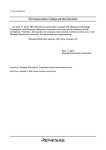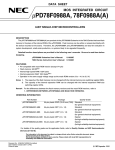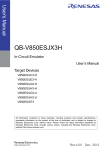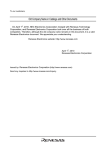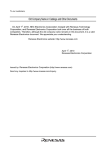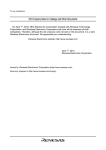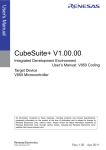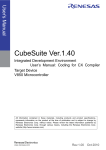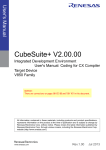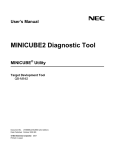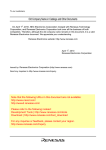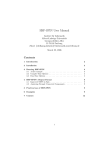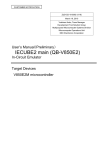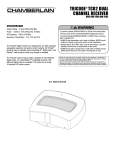Download QB-V850ESIX2 In-Circuit Emulator UM
Transcript
To our customers, Old Company Name in Catalogs and Other Documents On April 1st, 2010, NEC Electronics Corporation merged with Renesas Technology Corporation, and Renesas Electronics Corporation took over all the business of both companies. Therefore, although the old company name remains in this document, it is a valid Renesas Electronics document. We appreciate your understanding. Renesas Electronics website: http://www.renesas.com April 1st, 2010 Renesas Electronics Corporation Issued by: Renesas Electronics Corporation (http://www.renesas.com) Send any inquiries to http://www.renesas.com/inquiry. Notice 1. 2. 3. 4. 5. 6. 7. All information included in this document is current as of the date this document is issued. Such information, however, is subject to change without any prior notice. Before purchasing or using any Renesas Electronics products listed herein, please confirm the latest product information with a Renesas Electronics sales office. Also, please pay regular and careful attention to additional and different information to be disclosed by Renesas Electronics such as that disclosed through our website. Renesas Electronics does not assume any liability for infringement of patents, copyrights, or other intellectual property rights of third parties by or arising from the use of Renesas Electronics products or technical information described in this document. No license, express, implied or otherwise, is granted hereby under any patents, copyrights or other intellectual property rights of Renesas Electronics or others. You should not alter, modify, copy, or otherwise misappropriate any Renesas Electronics product, whether in whole or in part. Descriptions of circuits, software and other related information in this document are provided only to illustrate the operation of semiconductor products and application examples. You are fully responsible for the incorporation of these circuits, software, and information in the design of your equipment. Renesas Electronics assumes no responsibility for any losses incurred by you or third parties arising from the use of these circuits, software, or information. When exporting the products or technology described in this document, you should comply with the applicable export control laws and regulations and follow the procedures required by such laws and regulations. You should not use Renesas Electronics products or the technology described in this document for any purpose relating to military applications or use by the military, including but not limited to the development of weapons of mass destruction. Renesas Electronics products and technology may not be used for or incorporated into any products or systems whose manufacture, use, or sale is prohibited under any applicable domestic or foreign laws or regulations. Renesas Electronics has used reasonable care in preparing the information included in this document, but Renesas Electronics does not warrant that such information is error free. Renesas Electronics assumes no liability whatsoever for any damages incurred by you resulting from errors in or omissions from the information included herein. Renesas Electronics products are classified according to the following three quality grades: “Standard”, “High Quality”, and “Specific”. The recommended applications for each Renesas Electronics product depends on the product’s quality grade, as indicated below. You must check the quality grade of each Renesas Electronics product before using it in a particular application. You may not use any Renesas Electronics product for any application categorized as “Specific” without the prior written consent of Renesas Electronics. Further, you may not use any Renesas Electronics product for any application for which it is not intended without the prior written consent of Renesas Electronics. Renesas Electronics shall not be in any way liable for any damages or losses incurred by you or third parties arising from the use of any Renesas Electronics product for an application categorized as “Specific” or for which the product is not intended where you have failed to obtain the prior written consent of Renesas Electronics. The quality grade of each Renesas Electronics product is “Standard” unless otherwise expressly specified in a Renesas Electronics data sheets or data books, etc. “Standard”: 8. 9. 10. 11. 12. Computers; office equipment; communications equipment; test and measurement equipment; audio and visual equipment; home electronic appliances; machine tools; personal electronic equipment; and industrial robots. “High Quality”: Transportation equipment (automobiles, trains, ships, etc.); traffic control systems; anti-disaster systems; anticrime systems; safety equipment; and medical equipment not specifically designed for life support. “Specific”: Aircraft; aerospace equipment; submersible repeaters; nuclear reactor control systems; medical equipment or systems for life support (e.g. artificial life support devices or systems), surgical implantations, or healthcare intervention (e.g. excision, etc.), and any other applications or purposes that pose a direct threat to human life. You should use the Renesas Electronics products described in this document within the range specified by Renesas Electronics, especially with respect to the maximum rating, operating supply voltage range, movement power voltage range, heat radiation characteristics, installation and other product characteristics. Renesas Electronics shall have no liability for malfunctions or damages arising out of the use of Renesas Electronics products beyond such specified ranges. Although Renesas Electronics endeavors to improve the quality and reliability of its products, semiconductor products have specific characteristics such as the occurrence of failure at a certain rate and malfunctions under certain use conditions. Further, Renesas Electronics products are not subject to radiation resistance design. Please be sure to implement safety measures to guard them against the possibility of physical injury, and injury or damage caused by fire in the event of the failure of a Renesas Electronics product, such as safety design for hardware and software including but not limited to redundancy, fire control and malfunction prevention, appropriate treatment for aging degradation or any other appropriate measures. Because the evaluation of microcomputer software alone is very difficult, please evaluate the safety of the final products or system manufactured by you. Please contact a Renesas Electronics sales office for details as to environmental matters such as the environmental compatibility of each Renesas Electronics product. Please use Renesas Electronics products in compliance with all applicable laws and regulations that regulate the inclusion or use of controlled substances, including without limitation, the EU RoHS Directive. Renesas Electronics assumes no liability for damages or losses occurring as a result of your noncompliance with applicable laws and regulations. This document may not be reproduced or duplicated, in any form, in whole or in part, without prior written consent of Renesas Electronics. Please contact a Renesas Electronics sales office if you have any questions regarding the information contained in this document or Renesas Electronics products, or if you have any other inquiries. (Note 1) “Renesas Electronics” as used in this document means Renesas Electronics Corporation and also includes its majorityowned subsidiaries. (Note 2) “Renesas Electronics product(s)” means any product developed or manufactured by or for Renesas Electronics. User’s Manual QB-V850ESIX2 In-Circuit Emulator Target Devices V850ES/IE2 Document No. U17909EJ3V0UM00 (3rd edition) Date Published September 2007 NS © Printed in Japan 2006 [MEMO] 2 User’s Manual U17909EJ3V0UM IECUBE is a registered trademark of NEC Electronics Corporation in Japan and Germany. MULTI, Green Hills Software, TimeMachine, and SuperTrace are trademarks of Green Hills Software, Inc. • The information in this document is current as of September, 2007. The information is subject to change without notice. For actual design-in, refer to the latest publications of NEC Electronics data sheets or data books, etc., for the most up-to-date specifications of NEC Electronics products. Not all products and/or types are available in every country. Please check with an NEC Electronics sales representative for availability and additional information. • No part of this document may be copied or reproduced in any form or by any means without the prior written consent of NEC Electronics. NEC Electronics assumes no responsibility for any errors that may appear in this document. • NEC Electronics does not assume any liability for infringement of patents, copyrights or other intellectual property rights of third parties by or arising from the use of NEC Electronics products listed in this document or any other liability arising from the use of such products. No license, express, implied or otherwise, is granted under any patents, copyrights or other intellectual property rights of NEC Electronics or others. • Descriptions of circuits, software and other related information in this document are provided for illustrative purposes in semiconductor product operation and application examples. The incorporation of these circuits, software and information in the design of a customer's equipment shall be done under the full responsibility of the customer. NEC Electronics assumes no responsibility for any losses incurred by customers or third parties arising from the use of these circuits, software and information. • While NEC Electronics endeavors to enhance the quality, reliability and safety of NEC Electronics products, customers agree and acknowledge that the possibility of defects thereof cannot be eliminated entirely. To minimize risks of damage to property or injury (including death) to persons arising from defects in NEC Electronics products, customers must incorporate sufficient safety measures in their design, such as redundancy, fire-containment and anti-failure features. • NEC Electronics products are classified into the following three quality grades: "Standard", "Special" and "Specific". The "Specific" quality grade applies only to NEC Electronics products developed based on a customer-designated "quality assurance program" for a specific application. The recommended applications of an NEC Electronics product depend on its quality grade, as indicated below. Customers must check the quality grade of each NEC Electronics product before using it in a particular application. "Standard": Computers, office equipment, communications equipment, test and measurement equipment, audio and visual equipment, home electronic appliances, machine tools, personal electronic equipment and industrial robots. "Special": Transportation equipment (automobiles, trains, ships, etc.), traffic control systems, anti-disaster systems, anti-crime systems, safety equipment and medical equipment (not specifically designed for life support). "Specific": Aircraft, aerospace equipment, submersible repeaters, nuclear reactor control systems, life support systems and medical equipment for life support, etc. The quality grade of NEC Electronics products is "Standard" unless otherwise expressly specified in NEC Electronics data sheets or data books, etc. If customers wish to use NEC Electronics products in applications not intended by NEC Electronics, they must contact an NEC Electronics sales representative in advance to determine NEC Electronics' willingness to support a given application. (Note) (1) "NEC Electronics" as used in this statement means NEC Electronics Corporation and also includes its majority-owned subsidiaries. (2) "NEC Electronics products" means any product developed or manufactured by or for NEC Electronics (as defined above). M8E 02. 11-1 User’s Manual U17909EJ3V0UM 3 [MEMO] 4 User’s Manual U17909EJ3V0UM General Precautions for Handling This Product 1. Circumstances not covered by product guarantee • If the product was disassembled, altered, or repaired by the customer • If it was dropped, broken, or given another strong shock • Use at overvoltage, use outside guaranteed temperature range, storing outside guaranteed temperature range • If power was turned on while connection to the AC adapter, USB interface cable, or target system was in an unsatisfactory state • If the cable of the AC adapter, the USB interface cable, the emulation probe, or the like was bent or pulled excessively • If an AC adapter other than the supplied product was used • If the product got wet • If this product is connected to the target system when there is a potential difference between the GND of this product and GND of the target system. • If the connectors or cables are plugged/unplugged while this product is in the power-on state. • If excessive load is applied to the connectors or sockets. 2. Safety precautions • If used for a long time, the product may become hot (50°C to 60°C). Be careful of low temperature burns and other dangers due to the product becoming hot. • Be careful of electrical shock. There is a danger of electrical shock if the product is used as described above in 1 Circumstances not covered by product guarantee. • The AC adapter supplied with the product is exclusively for this product, so do not use it with other products User’s Manual U17909EJ3V0UM 5 INTRODUCTION Readers This manual is intended for users who wish to perform debugging using the QBV850ESIX2. The readers of this manual are assumed to be familiar with the device functions and usage, and to have knowledge of debuggers. Purpose This manual is intended to give users an understanding of the basic specifications and correct usage of the QB-V850ESIX2. Organization This manual is divided into the following sections. • General • Setup procedure • Settings at product shipment • Notes • Optional functions How to Read This Manual It is assumed that the readers of this manual have general knowledge in the fields of electrical engineering, logic circuits, and microcontrollers. This manual describes the basic setup procedures and how to set switches. To understand the overall functions and usages of the QB-V850ESIX2 → Read this manual according to the CONTENTS. The mark “<R>” shows major revised points. The revised points can be easily searched by copying an “<R>” in the PDF file and specifying it in the “Find what:” field. To know the manipulations, command functions, and other software-related settings of the QB-V850ESIX2 → See the user’s manual of the debugger (supplied with the QB-V850ESIX2) to be used. Conventions Note: Footnote for item marked with Note in the text Caution: Information requiring particular attention Remark: Supplementary information Numeric representation: Binary ... xxxx or xxxxB Decimal ... xxxx Hexadecimal ... xxxxH Prefix indicating power of 2 (address space, memory capacity): K (kilo): 210 = 1,024 M (mega): 220 = 1,0242 6 User’s Manual U17909EJ3V0UM Terminology The meanings of the terms used in this manual are described in the table below. Term Meaning Target device This is the device to be emulated. Target system This is the system to be debugged (system provided by the user). This includes the target program and the hardware provided by the user. IECUBE TM Generic name for NEC Electronics’ high-performance/compact in-circuit emulator. Related Documents Please use the following documents in combination with this manual. The related documents listed below may include preliminary versions. However, preliminary versions are not marked as such. Documents Related to Development Tools (User’s Manuals) Document Name Document Number QB-V850ESIX2 (in-circuit emulator) CA850 Ver. 3.00 C Compiler Package This manual Operation U17293E C Language U17291E Assembly Language U17292E Link Directives U17294E ID850QB Ver. 3.40 Integrated Debugger Operation U18604E SM+ System Simulator Operation U18010E User Open Interface U17663E Basics U13430E Installation U17419E Technical U13431E Task Debugger U17420E Basics U13773E Installation U17421E Technical U13772E Task Debugger U17422E RX850 Ver. 3.20 Real-Time OS RX850 Pro Ver. 3.20 Real-Time OS AZ850 Ver. 3.30 System Performance Analyzer U17423E PM+ Ver. 6.00 Project Manager U17178E Caution The related documents listed above are subject to change without notice. Be sure to use the latest version of each document for designing, etc. User’s Manual U17909EJ3V0UM 7 CONTENTS CHAPTER 1 GENERAL........................................................................................................................... 10 1.1 Hardware Specifications ................................................................................................................................11 1.2 System Specifications....................................................................................................................................12 1.3 System Configuration ....................................................................................................................................13 1.4 Package Contents ..........................................................................................................................................16 CHAPTER 2 SETUP PROCEDURE ........................................................................................................ 17 2.1 Names and Functions of Hardware...............................................................................................................18 2.2 Software Settings ...........................................................................................................................................20 2.3 2.4 2.5 2.2.1 When using ID850QB as debugger ....................................................................................................20 2.2.2 When using other than ID850QB (MULTITM, etc.) as debugger...........................................................20 Mounting and Connecting Connectors (When Using S Type)....................................................................20 2.3.1 Mounting target connector (TC) to target system ...............................................................................20 2.3.2 Plugging exchange adapter (EA) into TC ...........................................................................................21 2.3.3 Notes on handling TC, EA, MA, CA, or SA .........................................................................................21 Mounting and Connecting Connectors (When Using T Type)....................................................................22 2.4.1 Mounting TC in target system.............................................................................................................22 2.4.2 Connecting YQ on TC ........................................................................................................................22 2.4.3 Inserting EA into YQ ...........................................................................................................................23 2.4.4 Precautions for handling TC, YQ, and SA ..........................................................................................23 2.4.5 Precautions for mounting IC using TC and MA...................................................................................24 Connecting QB-V850ESIX2 to Target System..............................................................................................25 2.5.1 When not using extension probe (QB-144-EP-01S/02S)....................................................................25 2.5.2 When using extension probe (QB-144-EP-01S/02S)..........................................................................26 2.6 Connecting USB Interface Cable and AC Adapter.......................................................................................30 2.7 Switching Power On and Off .........................................................................................................................30 CHAPTER 3 SETTINGS AT PRODUCT SHIPMENT............................................................................ 31 CHAPTER 4 NOTES................................................................................................................................ 32 4.1 4.2 8 Cautions Regarding Differences Between Actual Device And Emulator...................................................32 4.1.1 Operation after power application to target system ............................................................................32 4.1.2 Oscillator ............................................................................................................................................32 4.1.3 Pin characteristics ..............................................................................................................................32 4.1.4 Notes on ROM correction function......................................................................................................32 4.1.5 Notes on flash self programming function...........................................................................................32 4.1.6 Notes on DBTRAP instruction ............................................................................................................32 4.1.7 On-chip debug function.......................................................................................................................32 4.1.8 Current consumption ..........................................................................................................................32 Notes On Debugging......................................................................................................................................33 4.2.1 Notes on Non-map Break ...................................................................................................................33 4.2.2 PSC Register Access .........................................................................................................................33 4.2.3 Notes on DBPC, DBPSW, and ECR Registers...................................................................................33 User’s Manual U17909EJ3V0UM 4.2.4 Notes on Trace Display Sequence .....................................................................................................33 4.2.5 Notes on Starting Debugger ...............................................................................................................33 4.2.6 Simultaneously Executing Two Instructions When Hardware Break Is Set ........................................34 4.2.7 Operation during Break ......................................................................................................................36 4.2.8 When an Illegal Break Occurs during Program Execution in Internal RAM ........................................37 4.2.9 Conflict between program execution for internal RAM and DMA transfer...........................................37 CHAPTER 5 OPTIONAL FUNCTIONS ...................................................................................................38 5.1 Coverage Measurement Function.................................................................................................................39 5.1.1 Functional outline ...............................................................................................................................39 5.1.2 Differences from hardware specifications...........................................................................................39 5.2 TimeMachine Function ..................................................................................................................................40 5.3 Changes to Top Side of Product Consequent to Addition of Optional Functions ...................................40 5.4 How to Add Optional Functions....................................................................................................................41 APPENDIX A REVISION HISTORY ........................................................................................................42 A.1 Major Revisions in This Edition ....................................................................................................................42 A.2 Revision History of Preceding Editions .......................................................................................................42 User’s Manual U17909EJ3V0UM 9 CHAPTER 1 GENERAL The QB-V850ESIX2 is an in-circuit emulator for emulating the V850ES/IE2. Hardware and software can be debugged efficiently in the development of systems in which the V850ES/IE2 is used. This manual descries basic setup procedures, hardware specifications, system specifications, and how to set switches. 10 User’s Manual U17909EJ3V0UM CHAPTER 1 GENERAL 1.1 Hardware Specifications Table 1-1. QB-V850ESIX2 Hardware Specifications Parameter Specification VDD = EVDD = 4.5 to 5.5 V Target system interface voltage AVDD = 4.5 to 5.5 V VSS = EVSS = AVSS = 0 V Maximum operating frequency 20 MHz Operating temperature range 0 to 40°C (No condensation) Storage temperature range −15 to +60°C (No condensation) External dimensions See figure below Power AC adapter 15 V, 1 A consumption Target system power supply Same level or lower than target device Weight 412 g Host interface USB interface (1.1, 2.0) 113 mm Note 1 109 mm Note 2 68 mm Note 3 Rear spacer Note 4 Front spacer Notes 1. Does not include projection of power switch 2. Includes projection of screw that fixes rear spacer 3. Dimension when rear spacer is made shortest (108 mm when longest) 4. Front spacer can vary from 20 mm (longest) to 5 mm (shortest) User’s Manual U17909EJ3V0UM 11 CHAPTER 1 GENERAL 1.2 System Specifications This section shows the QB-V850ESIX2 system specifications. For the usage of the debugging function, refer to ID850QB Ver. 3.40 Operation User’s Manual (U18604E). Table 1-2. QB-V850ESIX2 System Specifications Parameter Specification Emulation memory Internal ROM 1 MB max. capacity Internal RAM 60 KB max. External memory 16 MB max. (optional) (mapping possible in 1 MB units) Program execution Real-time execution function Go, Start from Here, Go & Go, Come Here, Restart, Return Out functions Non-real-time execution function Step In, Next Over, Slowmotion Break functions Hardware break Execution: 10 points Access: 6 points Trace functions Software break 2000 points Fail-safe break Non-map, I/O illegal, write protect Other Trace full break, forced break, timer overflow break Trace data types Branch-source PC, branch-destination PC, all PCs, all execution data, access data, access address, R/W status, time stamp, DMA point (start/end) Trace modes Real-time trace, Complete trace Trace events Delay trigger, section, qualify Memory capacity 256K frames Real-time RAM monitoring function 256 bytes × 8 points Time measurement Measurement clock 50 MHz functions Measurement objects Beginning through end of program execution Start event through end event (7 sections) Maximum measurement time Approximately 195 hours (When using measurement-dedicated clock divided by 32) Minimum resolution 20 ns Number of timers for measurement 8 Measurement results Execution time (Start through end of execution) Maximum, minimum, average, pass count (between events) Other Coverage function Detection of execution or pass (optional) Measured range Other functions Timer overflow break function (1 point) Internal ROM space + arbitrary 1 MB space Mapping function, event function, register manipulation function, memory manipulation function Caution 12 Depending on the debugger, some functions are not supported. User’s Manual U17909EJ3V0UM CHAPTER 1 GENERAL 1.3 System Configuration This section shows the system configuration when using the QB-V850ESIX2 connected to a host machine (a computer equipped with a USB port). Connection is possible even without optional products. Connectors <9> to <13> differ depending on the target device to be emulated. Figure 1-1. System Configuration (S Type) <5> <1> <3> <4> <2> <6> <7> : Products enclosed by broken lines are optional. <8> <9> <10> <12> <11> <13> <14> <1> Host machine: Computer equipped with a USB port Note 1 <2> ID850QB Disk/Accessory Disk : Debugger, USB drivers, manual, etc. <3> USB interface cable: Cable connecting QB-V850ESIX2 to host machine <4> AC adapter: Can support 100 to 240 V by replacing AC plug <5> QB-V850ESIX2: This product <6> Check pin adapter (option): Adapter used when observing waveforms on oscilloscope <7> Extension probe (flexible type) (option) <8> Extension probe (coaxial type) (option) <9> Exchange adapter: Adapter that performs pin conversion Notes 2, 3 <10> Check pin adapter (option): Adapter used when observing waveforms on oscilloscope Note 2 <11> Space adapter (option): Adapter for height regulation <12> Mount adapter (option): Adapter for socket mounting target device <13> Target connector: Connector soldered to target system <14> Target system Notes 1. Obtain device files from the NEC Electronics website. http://www.necel.com/micro/index_e.html 2. If both <10> and <11> are used, connection sequence of <10> and <11> may be reversed. 3. <8> is always required if <10> is used. User’s Manual U17909EJ3V0UM 13 CHAPTER 1 GENERAL Remark For notes on target system design and package drawings, refer to [Related Information] on the following webpage. URL: http://www.necel.com/micro/english/iecube/index.html Figure 1-2. System Configuration (T Type) <5> <1> <3> <4> <2> <6> <7> : Products enclosed by broken lines are optional. <8> <9> <10> <11> <12> <13> <14> <1> Host machine: Computer equipped with a USB port <2> ID850QB Disk/Accessory DiskNote: Debugger, USB drivers, manual, etc. <3> USB interface cable: Cable used for connecting QB-V850ESIX2 to host machine <4> AC adapter: Can support 100 to 240 V by replacing AC plug <5> QB-V850ESIX2: This product <6> Check pin adapter (optional): Adapter used for monitoring waveforms with oscilloscope <7> Extension probe flexible type (optional) <8> Extension probe coaxial type (optional) <9> Exchange adapter: Adapter that performs pin conversion <10> Space adapter (optional): Adapter used for height adjustment <11> Mount adapter (optional): Adapter used for mounting target device <12> YQ connector: Connector used for connecting emulator <13> Target connector: Connector to be soldered to target system <14> Target system Note Download the device file from the NEC Electronics website. http://www.necel.com/micro/index_e.html 14 User’s Manual U17909EJ3V0UM CHAPTER 1 GENERAL Remark For notes on target system design and package drawings, refer to [Related Information] on the following webpage. URL: http://www.necel.com/micro/english/iecube/index.html Table 1-3. List of Probe/Connector (S Type) Order Name No. Name V850ES/IE2 (64-Pin GC) <6> Check pin adapter QB-144-CA-01 (sold separately) <7> Extension probe (flexible type) QB-144-EP-02S (sold separately) <8> Extension probe (coaxial type) QB-144-EP-01S (sold separately) <9> Exchange adapter QB-64GC-EA-01S (sold separately) <10> Check pin adapter QB-64-CA-01S (sold separately) <11> Space adapter QB-64-SA-01S (sold separately) <12> Mount adapter QB-64GC-MA-01S (sold separately) <13> Target connector QB-64GC-TC-01S (sold separately) Note Note Table 1-4. List of Probe/Connector (T Type) Order Name No. Name V850ES/IE2 (64-Pin GC) <6> Check pin adapter QB-144-CA-01 (sold separately) <7> Extension probe (flexible type) QB-144-EP-02S (sold separately) <8> Extension probe (coaxial type) QB-144-EP-01S (sold separately) <9> Exchange adapter QB-64GC-EA-02T (sold separately) <10> Space adapter QB-64GC-YS-01T (sold separately) <11> Mount adapter QB-64GC-HQ-01T (sold separately) <12> YQ connector QB-64GC-YQ-01T (sold separately) <13> Target connector QB-64GC-NQ-01T (sold separately) Note Note Note Note These accessories are supplied depending on the part number ordered. User’s Manual U17909EJ3V0UM 15 CHAPTER 1 GENERAL 1.4 Package Contents The following items have been placed in the QB-V850ESIX2 packing box. Please check the contents. Products supplied with QB-V850ESIX2-ZZZ 1: QB-V850ESIX2 2: AC adapter 3: USB interface cable 4: ID850QB Disk (CD-ROM) 5: Accessory Disk (CD-ROM) 6: IECUBE Setup Manual 7: User registration (Guarantee card and software contract in one) 8: Simple flash memory programmer (PG-FPL or QB-MINI2) 9: Probe holder 10: Parts board (for clock) Products supplied with QB-V850ESIX2-S64GC 1 to 10 11: Exchange adapter QB-64GC-EA-01S 12: Target connector QB-64GC-TC-01S Products supplied with QB-V850ESIX2-T64GC 1 to 10 11: 16 Exchange adapter QB-64GC-EA-02T 12: YQ connector QB-64GC-YQ-01T 13: Target connector QB-64GC-NQ-01T User’s Manual U17909EJ3V0UM CHAPTER 2 SETUP PROCEDURE This chapter explains the QB-V850ESIX2 setup procedure. Setup can be completed by performing installation/setup in the order in which it appears in this chapter. Perform setup along the lines of the following procedure. Software settings See 2.2 Software Settings. Mounting and connecting connectors When using the S Type, see 2.3 Mounting and Connecting Connectors (When Using S Type). When using the T Type, see 2.4 Mounting and Connecting Connectors (When Using T Type). Connecting QB-V850ESIX2 to target system See 2.5 Connecting QB-V850ESIX2 to Target System. • When not using the extension probe (QB-144-EP-01S/02S): see 2.5.1. • When using the extension probe (QB-144-EP-01S/02S): see 2.5.2. Connecting USB interface cable and AC adapter See 2.6 Connecting USB Interface Cable and AC adapter. Switching power on and off See 2.7 Switching Power On and Off. User’s Manual U17909EJ3V0UM 17 CHAPTER 2 SETUP PROCEDURE 2.1 Names and Functions of Hardware Figure 2-1. Names of Parts of QB-V850ESIX2 Bottom View Top View Power switch MAIN CLOCK JP1 JP2 JP3 JP4 POWER 18 TARGET CN3 CN2 CN1 User’s Manual U17909EJ3V0UM CHAPTER 2 SETUP PROCEDURE (1) CN1, CN2, CN3 These connectors are used to connect the exchange adapter or extension probe. (2) MAIN CLOCK (for clock) This parts board is used to mount the resonator. An oscillator with a 5 MHz resonator and a capacitor are mounted at shipment. The actually used clock is divided into two and set to 2.5 MHz. Other settings are prohibited. (3) JP1 This jumper is used to change the setting depending on the operating frequency. Pins 2 and 3 are shorted at shipment. Other settings are prohibited. (4) JP2 This jumper is used for delivery inspection. All the pins of this jumper are open at shipment. Other settings are prohibited. (5) JP3 This jumper is used to change the setting depending on the type of the clock mounted on the MAIN CLOCK. Pins 1 and 2, and pins 3 and 4 are shorted, pins 5 and 6, and pins 7 and 8 are left open at shipment. Other settings are prohibited. (6) JP4 This jumper is used to change the setting depending on the target device. Pins 1 and 2 are shorted at shipment. Other settings are prohibited. (7) POWER (Red LED) This is an LED that shows whether or not the power supply of the QB-V850ESIX2 is switched on. LED State QB-V850ESIX2 State Lit Power switch ON Not lit Power switch OFF or AC adapter not connected to QB-V850ESIX2 Blinking Internal error occurred (Contact an NEC Electronics sales representative or distributor) (8) TARGET (Green LED) This is an LED that shows whether or not the power supply of the target system is switched on. LED State Target System State Lit Target system power supply ON Not lit Target system power supply OFF or target system not connected (9) Power switch This is the power switch of the QB-V850ESIX2. It is OFF at shipment. User’s Manual U17909EJ3V0UM 19 CHAPTER 2 SETUP PROCEDURE 2.2 2.2.1 Software Settings When using ID850QB as debugger For details, refer to the V850 Series Integrated Debugger ID850QB Operating Precautions supplied with the debugger (ID850QB). 2.2.2 When using other than ID850QB (MULTITM, etc.) as debugger Refer to the user’s manual of the debugger used and the V850 IECUBE Setup Manual (supplied). 2.3 Mounting and Connecting Connectors (When Using S Type) This section describes the methods for connecting the QB-V850ESIX2 to the target system when using the S Type. Make connections with both the QB-V850ESIX2 and target system powered off. The following abbreviations are used in this section. • TC: Target connector • EA: Exchange adapter • MA: Mount adapter • CA: Check pin adapter • SA: Space adapter 2.3.1 Mounting target connector (TC) to target system (1) Apply cream solder to the foot pattern of the target system for mounting an IC. (2) A circular projection is at the center of the bottom side of TC (refer to Figure 2-2). Sparingly apply two-liquid hardening epoxy adhesive (type that hardens in 15 to 30 minutes is recommended) to temporarily secure the connector at the specified position on the target system. At this time, match the position of pin 1 (position where a corner of the connector is cut into shape C) with the position of pin 1 from the target system. Figure 2-2. TC Projection (3) Soldering condition of TC (a) Reflow soldering At 245°C for a maximum of 20 seconds (main heating) (b) Manual soldering At 320°C for a maximum of 5 seconds (per pin) (4) Precautions on flux splatter If the solder flux splatters when the connector is soldered, faulty contact may occur. Be sure to cover the upper part of the connector with aluminum foil. Do not clean the connector because the flux solvent may remain inside the connector. 20 User’s Manual U17909EJ3V0UM CHAPTER 2 SETUP PROCEDURE 2.3.2 Plugging exchange adapter (EA) into TC Match the No. 1 pin position of the EA, MA, CA, or SA to the No. 1 pin position of the TC and plug in (C cuts match in both). (a) When plugging or unplugging, hold down the TC with your fingers so that there is no force on the TC. (b) When plugging or unplugging, be careful of the direction of rocking (refer to Figure 2-3). As a tool when unplugging, insert some kind of thin non-conductive material such as a wooden stick in between the TC and EA and rock in the direction shown in Figure 2-3 while slowly unplugging. Be careful since the connector will be damaged if this is done in the wrong direction. Figure 2-3. Plugging and Unplugging 2.3.3 Notes on handling TC, EA, MA, CA, or SA (1) Cause of faulty contact of connector (a) If flux gets inside the connector when TC is soldered It is easy for flux to get inside of the connector. Clean the connector several times with a solvent such as alcohol if flux gets inside. If conduction is still unstable, repeat cleaning. (b) If dust gets inside the connector Faulty contact occurs if dust such as a thread gets inside the connector. Remove dust with a brush. (c) Notes on using CA or SA When CA or SA is used, a fractional delay time of signal propagation and a little capacitance are generated as a result of inserting the adapter. Make a thorough evaluation by connecting the target system. (2) Notes on inserting and removing the connector (a) When inserting or removing the connector, be sure to hold down the lower (mating) connector or board with your fingers. (b) Before inserting a connector, make sure that the connectors are correctly positioned. If the connector is inserted incorrectly positioned, it may be damaged. (c) When removing a connector, insert some kind of thin non-conductive material such as a wooden stick beneath the connector to protect the board from being damaged. Do not remove the connector all at once. Remove the connector by jiggling it bit by bit. If only a metallic object such as a screwdriver is available, wind a soft cloth around its tip. User’s Manual U17909EJ3V0UM 21 CHAPTER 2 SETUP PROCEDURE 2.4 Mounting and Connecting Connectors (When Using T Type) This section describes the methods for connecting the QB-V850ESIX2 to the target system when using the T Type. Make connections with both the QB-V850ESIX2 and target system powered off. The following abbreviations are used in this section. • TC: Target connector • YQ: YQ connector • EA: Exchange adapter • MA: Mount adapter • CA: Check pin adapter • SA: Space adapter 2.4.1 Mounting TC in target system (1) Thinly apply a two-component epoxy adhesive (hardening time at least 30 minutes) to the ends of the four projections on the base of the TC and adhere the TC to the user board (clean the surface of the user board using alcohol or the like). If alignment of user board pads to TC leads is difficult, align them as in (2). (2) Align by inserting the guide pins for alignment for the TC (NQGUIDE) through the pin holes on the top of the TC. Accessory holes are φ1.0 mm non-through holes in two or three places. (For hole positions, see the particular TC drawing.) (3) Solder after fitting the MA to the TC. This is to prevent troubles such as flux or solder splatter and adhering to the TC contact pins when soldering. ● Soldering conditions Caution Solder reflow At 240°C for a maximum of 20 seconds Manual soldering At 240°C for a maximum of 10 seconds (per pin) Do not perform cleaning by flux immersion or vapor. (4) Remove the guide pins. 2.4.2 Connecting YQ on TC (1) After confirming that there are no broken or bent YQ contact pins, fit the YQ in the TC and fasten it using <R> the supplied YQGUIDE (for the fastening method, see the next step, (2)). If repeatedly inserting and removing, be sure to inspect the YQ pins before fitting. If pins are bent, correct them using something thin and flat such as the edge of a knife. 22 User’s Manual U17909EJ3V0UM CHAPTER 2 SETUP PROCEDURE (2) Fasten YQ to the TC on the target system using the supplied YQGUIDE. Fasten the screws equally in the <R> four corners using the supplied flat-blade screwdriver or a torque driver. The tightening torque of YQGUIDE is 0.054 Nm (MAX.). Too great tightening causes bad connections. Four screws for fitting to the MA (M2 x 10 mm / 4 units) are included with YQ. EA YQGUIDE supplied with YQ YQ TC Target system 2.4.3 Inserting EA into YQ Match the pin 1 position of the YQ or SA (corner cuts match in both) to the pin 1 position of the EA and insert it. • When inserting or removing, press on the TC, YQ, and SA with a finger so that there is no force on the TC. • When inserting or removing, be careful of the direction of wiggling. As a tool when removing, insert some kind of thin non-conductive material such as a wooden stick between the YQ (SA) and EA and wiggle it while slowly removing. Be careful since the connector will be damaged if this is done in the wrong direction. 2.4.4 Precautions for handling TC, YQ, and SA (1) When taking the TC from the box, press down on the body and take out the sponge first. (2) Since the pins of the YQ are thin and easily bent, be careful. When inserting it in the TC, confirm that there are no bent pins. (3) When screwing a YQ soldered to a board to the TC, fasten the screws in four places in turn using a #0 or #1 Phillips precision screwdriver or torque driver after tentatively tightening them. Fix the torque at 0.054 Nm (MAX.). If just one place is overtightened, it may cause poor contact. Moreover, a board being connected to the YQ must have accessory holes in prescribed positions (4 places: φ2.3 mm or φ3.3 mm). The φ3.8 mm or φ4.3 mm that is the screw head size is an area where wiring is prohibited. (4) In YQ and SA removal, since there is a danger of YQ pins being bent or broken when prying and wiggling, remove them gradually using a flatbladed screwdriver from four directions. Moreover, to connect and use the YQ and SA, screw the YQ to the TC according to the YQGUIDE (sold separately) using a 2.3 mm flatbladed screwdriver and then connect it to the SA. Fix the torque at 0.054 Nm (MAX.). If even one place is overtightened, it may cause poor contact. (5) For the TC, YQ, and SA, since there is a danger that cleaning fluid on the structure will remain in the connector, do not perform cleaning. (6) TC, IC, and YQ cannot be used in combination. (7) An TC/YQ system cannot be used in an environment of vibrations or shocks. User’s Manual U17909EJ3V0UM 23 CHAPTER 2 SETUP PROCEDURE (8) It is assumed that this product will be used in system development and evaluation. Moreover, when used in Japan, Electrical Appliance and Material Control Law and electromagnetic disturbance countermeasures have not been applied. (9) Since there are rare cases of shape change if the box is left for a long time in a place where it is 50°C or higher, for safekeeping, store it in a place where it is no higher than 40°C and direct sunlight does not hit it. (10) For details about handling the TC, YQ, and SA, see the NQPACK series technical materials at the website of Tokyo Eletech Corporation. Tokyo Eletech Corporation website: http://www.tetc.co.jp/ 2.4.5 Precautions for mounting IC using TC and MA (1) Confirm that there is no weld flash in the resin (sealant part) of the IC. If there is weld flash, remove it using a knife or the like. (2) Confirm that there is no weld flash breaking or bending of IC leads. In particular, confirm the planarity of IC leads. If there is abnormality in the planarity, correct that portion. (3) Viewing the TC contact pins from the top, if there are foreign bodies on them, remove them using a brush or the like. After confirming (1) to (3), fit the IC to the TC. Also fit the MA. (4) Put the supplied M2 × 6 mm screws in the four accessory holes of the MA and fasten the screws in opposite corners. At that time, use either the dedicated screwdriver that is supplied or a torque driver to fasten them equally in turn with a tightening torque of 0.054 Nm (MAX.). Since the contact is poor if tightening is too great, once you have lightly fastened the MA screws, tighten them again. (5) Depending on the use environment, when starting up a device that has been left for a long time, starting it may be difficult. In this case, loosen the screws slightly and then retighten them. (6) If startup still is difficult after (5) above, check (1) to (3) again. (7) Tightening the screws of the MA too much may give rise to cracks in the molded part of the MA (plastic part) and bend the mold into a bowed shape, making contact poor. (8) After soldering the TC, do not perform cleaning by flux immersion or vapor. 24 User’s Manual U17909EJ3V0UM CHAPTER 2 SETUP PROCEDURE 2.5 2.5.1 Connecting QB-V850ESIX2 to Target System When not using extension probe (QB-144-EP-01S/02S) The QB-V850ESIX2 can be connected to the target system without using an extension probe. Adjust the height by using the spacer at the rear part of the QB-V850ESIX2, so that no stress is applied to the exchange adapter, the target connector, and other connectors. Sufficiently insulate the target system. Figure 2-4. Connection without Extension Probe QB-V850ESIX2 Height adjustable Exchange adapter Rear spacer Target connector User’s Manual U17909EJ3V0UM 25 CHAPTER 2 SETUP PROCEDURE 2.5.2 When using extension probe (QB-144-EP-01S/02S) When using the extension probe (QB-144-EP-01S/02S), connect the QB-V850ESIX2 and the target system in the following procedure. (a) Connecting probe holder Use the probe holder (supplied with the QB-V850ESIX2) to connect the extension probe to the QB-V850ESIX2, as shown below. Figure 2-5. Using Probe Holder <1> Connect the QB-V850ESIX2 and probe. Extension probe Probe holder Insert QB-V850ESIX2 <2> Insert the probe holder into QB-V850ESIX2. Insert the probe holder into QB-V850ESIX2 until you hear a click (note the direction). (b) Connection of extension probe GND wire There are 3 GND wires in the extension probe. Connect them to the QB-V850ESIX2 and target system. <1> Fasten the GND wire on the QB-V850ESIX2 side of the extension probe to the nut on the bottom of the QB-V850ESIX2 using a #0 or #1 Phillips precision driver (connection of (B) to (A) in Figure 2-6). <2> Next plug the connector on top of the extension probe into the connector at the opening on the bottom of the QB-V850ESIX2 from below being careful of the insertion direction (connection of (C) in Figure 2-6 to QB-V850ESIX2). 26 User’s Manual U17909EJ3V0UM CHAPTER 2 SETUP PROCEDURE Figure 2-6. GND Wire QB-V850ESIX2 Target system <3> Connect the exchange adapter and extension probe to the target connector. <4> Connect two GND wires on the target system side of the extension probe to the target system GND. If a pin or screw is fastened to the target system GND, remove the transparent terminal cover on the end of the GND wire and fasten the Y type pin of the GND wire to the target system ((G) in Figure 2-6). If the GND on the target system is an exposed pad, likewise fasten the Y type pin to the pad on the target system by soldering ((H) in Figure 2-6) (recommended soldering iron temperature setting: 300°C). <5> If the target system has only one GND, connect only one of the GND wires of the extension probe. Cut off the other GND wires with a nipper or leave it as is without removing the pin cover. User’s Manual U17909EJ3V0UM 27 CHAPTER 2 SETUP PROCEDURE <6> Since the length of the GND wire below the head (insulated part) is approximately 60 mm, there must be at least a GND to which it can be connected to within the range of the three approximately 60 mm radius sections of the target system for connecting the extension probe, as shown in Figure 2-7. The GND wire of the extension probe is soldered to positions J and K in Figure 2-7. To connect it to position L, remove the wire soldered to J or K and then solder it to L. Figure 2-7. Where GND Wire Can Be Connected Target system 28 User’s Manual U17909EJ3V0UM CHAPTER 2 SETUP PROCEDURE (c) Ensuring isolation When connecting the target system to the QB-V850ESIX2 using an extension probe, adjust the height using the front spacer or rear spacer of the QB-V850ESIX2 and ensure isolation from the target system. Figure 2-8. Connection Using Extension Probe QB-V850ESIX2 Extension probe Exchange adapter Rear spacer (Height adjustable) Front spacer (Height adjustable) Target connector (d) Cautions related to extension probe The following cautions pertain to using the extension probe. <1> Be careful that stress of the extension probe is not placed on the target connector. Moreover, when removing the extension probe, remove it slowly while holding down on the exchange adapter with a finger so that there is no stress on the target connector. <2> Be sure to connect the GND wire of the extension probe to the QB-V850ESIX2 and the target system. If not, the impedance of the cable becomes unstable, resulting in the lowering of signal transmission characteristics or distortion of the output waveform for an input waveform. User’s Manual U17909EJ3V0UM 29 CHAPTER 2 SETUP PROCEDURE 2.6 Connecting USB Interface Cable and AC Adapter Plug the USB interface cable supplied with the QB-V850ESIX2 into the USB connector of the host machine, and plug the other side into the USB connector on the rear of the QB-V850ESIX2. Plug the AC adapter supplied with the QB-V850ESIX2 into a receptacle and plug the other side into the power supply connector on the rear of the QB-V850ESIX2. For QB-V850ESIX2 connector positions, see Figure 2-9. By replacing the AC plug, the AC adapter can support the voltage from 100 to 240 V. The AC plug for 100 V is attached when shipped. Replace it with the AC plug for 220 or 240 V (supplied with the QB-V850ESIX2) when the AC adapter is used at 220 or 240 V. Figure 2-9. Connector Positions Power supply connector (Connect AC adapter) USB connector (Connect USB interface cable) 2.7 Switching Power On and Off Be sure to switch the power on and off according to the following procedures. • Switching power on • Switching power off <1> QB-V850ESIX2 power on Note <1> Debugger termination Note <2> Target system power on <2> Target system power off <3> Debugger startup <3> QB-V850ESIX2 power off Note In the procedures, <2> is unnecessary if the target system is not connected. Caution 30 If the wrong sequence was used for the operation, the target system or QB-V850ESIX2 may fail. User’s Manual U17909EJ3V0UM CHAPTER 3 SETTINGS AT PRODUCT SHIPMENT Table 3-1. Settings at Shipment Item Setting JP1 Remarks Pins 2 and 3 are shorted. 3 2 1 Do not change this setting. All pins are left open. JP2 JP3 1 3 5 2 4 6 8 6 4 2 7 5 3 1 open. Do not change this setting. Do not change this setting. 3 2 1 Power switch Pins 1 and 2, 3 and 4 are shorted, pins 5 and 6, 7 and 8 are left Pins 1 and 2 are shorted. JP4 MAIN CLOCK Do not change this setting. 8 9 10 11 12 13 14 7 6 5 4 3 2 1 A 5 MHz resonator is connected to pins 3 and 12. A 27 pF capacitor is connected to pins 2 and 13, and pins 5 and 10. Do not change this setting. Set to OFF at shipment. User’s Manual U17909EJ3V0UM 31 CHAPTER 4 NOTES 4.1 Cautions Regarding Differences Between Actual Device And Emulator When debugging is performed with QB-V850ESIX2 connected to the target system, QB-V850ESIX2 performs emulation as if the actual device operates in the target system, although operations of the actual device and QBV850ESIX2 differ in the following points. Therefore, the user is responsible for using the actual device for the final evaluation before starting mass production and judging its applicability. 4.1.1 Operation after power application to target system The target device mounted in the target system starts program execution when reset is released after power application. With QB-V850ESIX2, however, the program will not be executed until manipulation to start the program downloaded with the debugger is performed. QB-V850ESIX2 can download and execute objects even before their initial value information of a variable is ROMized, but the actual device does not operate normally if the objects have not been ROMized. For details on ROMization, refer to the user’s manual of the compiler. 4.1.2 Oscillator QB-V850ESIX2 does not support clock input from the oscillator in the target system. The operating cock frequency may therefore vary between when the target device is mounted and when QB-V850ESIX2 is connected. 4.1.3 Pin characteristics Since the connectors, adapters and circuit board are placed between QB-V850ESIX2 and the target system, unlike when the target device is mounted in the target system, the electrical characteristics of the pins differ. In particular, note that the A/D converter conversion results can easily be affected. When an extension probe is connected, one additional data wait must be inserted into the external bus. 4.1.4 Notes on ROM correction function QB-V850ESIX2 does not support emulation of the ROM correction function. To use this function, make an evaluation by using the target device. 4.1.5 Notes on flash self programming function The flash self programming function cannot be emulated. To use this function, make an evaluation by using an onchip debug emulator or the target device. Some devices support the pseudo emulation function, using a debugger. For the usage, refer to ID850QB Ver. 3.40 Operation User’s Manual (U18604E). 4.1.6 Notes on DBTRAP instruction The DBTRAP instruction cannot be used in the user program because it is used for software breaks. 4.1.7 On-chip debug function Emulation of the on-chip debug function is not possible. 4.1.8 Current consumption The current consumed by QB-V850ESIX2 differs from that of the actual device. The current consumption of QB-V850ESIX2 is equal to or lower than that of the actual device during normal operation, and HALT and IDLE modes, but it becomes higher than that in the actual device in the STOP mode. 32 User’s Manual U17909EJ3V0UM CHAPTER 4 NOTES 4.2 Notes On Debugging 4.2.1 Notes on Non-map Break Figure 4-1. Break at Fetching Unused Area If a program is fetched from an area not used by a program (unused area) with an emulator, a non-map break usually occurs. However, a non-map break does not occur Used area (Non-map break does not occur) in the first 16-byte space of each unused area (refer to Figure 4-1). 4.2.2 Unused area (Non-map break occurs) 16 bytes PSC Register Access Data is written to the PSC register in the following sequence. If a software break is set to the NOP instruction Used area (Non-map break does not occur) Non-map break does not occur in this area immediately after the register has been accessed, the Unused area (Non-map break occurs) debugger hangs up. Example: 16 bytes mov 0x2,r1 Used area (Non-map break does not occur) st.b r1,prcmd st.b r1,psc nop ← Debugger hangs up if a software break is set here. nop ← There is no problem if a software break is set here or later. To set a break immediately after the PSC register has been written, use a hardware break. 4.2.3 Notes on DBPC, DBPSW, and ECR Registers The DBPC, DBPSW, and ECR registers cannot be accessed during a break. If a value is written to any of these registers during a break, the written value is ignored. If these registers are read, 0 is always read. 4.2.4 Notes on Trace Display Sequence When the trace mode that displays the access history is used, the display sequence may be reversed. • If read and write instructions are successively executed • If a bit manipulation instruction that executes read-modify-write is executed (such as SET, NOT, or CLR) In both the cases, the trace results of write and read are displayed in that order. 4.2.5 Notes on Starting Debugger When the debugger is started, the following warning or error may occur depending on the setting of the debugger and the status of the target system. This is because the status of the target system is not in accordance with the setting of the debugger. If a warning or error occurs, check the status of the target system or the setting of the debugger. It is recommended that the conversion adapter be connected to the QB-V850ESIX2 even when the target system is not connected. If the conversion adapter is not connected, the value of the input port may not be correctly read. User’s Manual U17909EJ3V0UM 33 CHAPTER 4 NOTES • ID850QB Error No. Error Message “Target” Field of ID850QB Target System Exchange Target System Configuration Window Connection Adapter Power Connect Not Connect Connected Not Used Connected Ff606 Not ON OFF Used Check connection with the target and turn on power to √ √ the target. Wf607 Check the connection of the √ conversion adapter. Ff608 Disconnect the target. Ff609 Turn off power to the target √ √ √ √ √ √ and disconnect the target. √ √ • MULTI Error Message “-tc” of 850eserv Start Target System Exchange Target System Option Connection Adapter Power With -tc Without Connected -tc Check the target power on. Or please delete “-tc” option. Used Not ON √ √ Remove the target. Or please add “-tc” √ option and power on the target. Power off and remove the target. Or √ √ √ √ √ please add “-tc” option. OFF Used √ Check the exchange adapter is connected. 4.2.6 Not Connected √ √ Simultaneously Executing Two Instructions When Hardware Break Is Set If a hardware break is set at the first or the next of two instructions that are executed at the same time, the following phenomena may occur. • Break occurs at a place different from where it has been set. • The set break does not occur. To prevent these phenomena, set a software break. The conditions under which two instructions are simultaneously executed are shown on the following pages. 34 User’s Manual U17909EJ3V0UM CHAPTER 4 NOTES [Combination of instructions for the occurrence of the simultaneous execution of two instructions] • Condition where “mov + operation instruction” are executed as one instruction If dst of mov and dst of the operation instruction are the same register, except r0, in combination of “mov src, dst” and one of the following instructions: Format I satsubr/satsub/satadd/mulh or/xor/and subr/sub/add Format II Remark shr/sar/shl/mulh “mov + operation instruction” are executed as one instruction only when the mov instruction is the first instruction of the above combinations of instructions. • Condition of parallel execution of instructions <1> Combination of one of the following instructions and br instruction Format I nop/mov/not/sld satsubr/satsub/satadd/mulh or/xor/and/tst subr/sub/add/cmp Format II mov/satadd/add/cmp shr/sar/shl/mulh Format IV sld.b/sst.b/sld.h/sst.h/sld.w/sst.w <2> Combination of one of the following instructions (instructions that do not update flags) and bcc instruction except br instruction Format I nop/mov/sld Format II mov/mulh Format IV sld.b/sst.b/sld.h/sst.h/sld.w/sst.w mulh/sxb/sxh/zxb/zxh <3> Combination of one of the following instructions and sld instruction Format I nop/mov/not satsubr/satsub/satadd/mulh or/xor/and/tst subr/sub/add/cmp Format II mov/satadd/add/cmp shr/sar/shl/mulh Remark Of <1> to <3>, two instructions are simultaneously executed only when the second instruction of the above combinations of instructions is br/brcc/sld Caution Formats I, II, and IV are the instruction formats described in the V850ES Architecture User’s Manual (U15943E). User’s Manual U17909EJ3V0UM 35 CHAPTER 4 NOTES • Cases in which two instructions are not simultaneously executed In the following cases, two instructions are not simultaneously executed. (a) If the first instruction is the first instruction after execution branches to an address that is not word aligned. Example 0x1006 mov r10,r12 0x1008 sld.b 0x8[ep],r11 If a branch to address 0x1006 occurs, the two instructions are not executed simultaneously because the first instruction is not word aligned (because the lower 1 byte of the address is not 0, 4, 8, A, or C). (b) If the second instruction is sld and writing to the ep register is not completed. Example 0x1004 mov r10,ep 0x1006 sld.b 0x8[ep],r11 In this case, the value of r10 is written to the ep register by the mov instruction at address 0x1004. However, the two instructions are not executed simultaneously because WB (writeback) of the mov instruction is not completed when the sld.b instruction at address 0x1006 is executed. (c) If the second instruction is bcc (conditional branch instruction) and a flag hazard occurs (the instruction immediately before or the instruction before that instruction may update the flags). Example 0x1004 cmp r0,r10 0x1006 bn 0xf0 The bn instruction that references the S flag and branches must wait for execution of the cmp instruction at address 0x1004 because the S flag is changed by the cmp instruction. As a consequence, the bn instruction causes a flag hazard and the two instructions are not executed simultaneously. (d) If the second instruction is sld and both of the load buffers are in the WB wait status. Example Suppose that the following instructions are located in the memory. 0x1000 nop 0x1002 nop 0x1004 ld.w 0x3000[r10],r11 0x1008 ld.w 0x3004[r10],r12 0x100c mov r8,r9 0x100e sld.b 0x10[ep],r13 If ld.w at addresses 0x1004 and 0x1008 accesses the external memory, several clocks of wait states are inserted. If the instruction at address 0x100e is executed, then the load buffer is in the “WB wait” status because WB of the ld.w instructions at addresses 0x1004 and 0x1008 is not completed, and the two instructions at address 0x100c and 0x100e are not simultaneously executed. 4.2.7 Operation during Break Since various peripheral functions operate even during breaks in the in-circuit emulator, interrupts due to peripheral functions, generated during breaks, are suspended and, when re-executing after the breaks, execution may occur after processing of suspended interrupts. The watchdog timer counter, however, stops during the breaks. The following peripheral functions can be stopped when using the peripheral break functions. When using the ID850QB, this setting can be made in the Configuration dialog box. 36 User’s Manual U17909EJ3V0UM CHAPTER 4 NOTES • Timer P • Timer Q • Timer M 4.2.8 When an Illegal Break Occurs during Program Execution in Internal RAM An illegal break may occur when a peripheral I/O register is accessed during program execution in the internal RAM. A non-map break occurs if all of the following conditions are satisfied, even if the program itself is correct. • A program is executed in the internal RAM area. • Data access for the internal RAM area is performed twice in succession. • An execution branches to the internal ROM area using a JR or JARL instruction immediately after the above successive data access, or one NOP instruction after the above successive data access. In order not to generate the break, cancel the fail-safe break setting for the internal RAM in the debugger. <When using ID850QB> Click the [Detail] button in the Fail-safe Break field in the Configuration window and clear the check in the check box for “Internal RAM”. <When using MULTI> Cancel the fail-safe break for “ramgrd” and “ramgrdv” using the Target flsf command. 4.2.9 Conflict between program execution for internal RAM and DMA transfer If the following two operations are executed at the same time, the CPU may deadlock due to an internal bus conflict. • Instruction for accessing data at addresses mis-aligned in the internal RAM • DMA transfer for the internal RAM User’s Manual U17909EJ3V0UM 37 CHAPTER 5 OPTIONAL FUNCTIONS The following functions can be added to the QB-V850ESIX2. This chapter explains the functional outline and specifications of the optional functions, and how to obtain them. • Coverage measurement function • TimeMachineTM function The support status of each optional function differs depending on the debugger used. The following table lists the support statuses as of February 2007. If you have any questions regarding the support status, consult an NEC Electronics sales representative or distributor. Function Support Status ID850QB 38 MULTI Coverage measurement function Supported in V2.90, V3.10 and later Support under consideration TimeMachine function Not supported Supported in 850eserv2 V1.000 and later User’s Manual U17909EJ3V0UM CHAPTER 5 OPTIONAL FUNCTIONS 5.1 Coverage Measurement Function This section explains the functional outline of the coverage measurement function and differences in specifications that occur after the addition of this function. 5.1.1 Functional outline The coverage measurement function is used to measure the percentage of the executed code in a load module, section, or other such area. After the addition of this function, the Code Coverage window will be added and the Source and Assemble windows will be modified in the debugger ID850QB, as follows. • Code Coverage window Displays the coverage (%) of the executed code for total code in a load module. Displays the coverage (%) of the executed code separately by functions, • Source window and Assemble window sections and vectors. The executed lines are highlighted. Refer to the user’s manual for the debugger for details on use of the coverage measurement function. 5.1.2 Differences from hardware specifications After addition of the coverage measurement function, differences from the hardware specifications described in this manual are as follows. • External dimensions The height increases by 9 mm. 68 mm 77 mmNote Note When the rear spacer is adjusted to the lowest height (107 mm max.) • Weight The weight increases by approximately 70 g. User’s Manual U17909EJ3V0UM 39 CHAPTER 5 OPTIONAL FUNCTIONS 5.2 TimeMachine Function This function is supported by the Green Hills Software (GHS) debugger. For details on the functional outline and specifications, consult a GHS tool distributor. 5.3 Changes to Top Side of Product Consequent to Addition of Optional Functions After the addition of the optional functions, the following stickers will be attached to the top of the QB-V850ESIX2. The addition of the optional functions can be confirmed through the presence of these stickers. A sticker is attached to this position according to the function added, as follows. For the coverage measuring function: For the TimeMachine function: QB-V850ESIX2 Top View 40 User’s Manual U17909EJ3V0UM CHAPTER 5 OPTIONAL FUNCTIONS 5.4 How to Add Optional Functions To add the optional functions, the option board corresponding to each function, as listed in the following, must be mounted. Function Option Board Required for Adding Function Note 1 Coverage measurement function Coverage memory board TimeMachine function SuperTrace TM Probe board Notes 1, 2 Notes 1. Either the coverage memory board or the SuperTrace Probe board can be added, but not both. 2. To use the TimeMachine function, the SuperTrace Probe (Green Hills Software (GHS)) must be mounted in the QB-V850ESIX2, in addition to the SuperTrace Probe board. For details on specifications and purchases, consult a GHS tool distributor. The following two methods have been provided for mounting the option boards. For more information on ordering, price and schedule, consult an NEC Electronics sales representative or distributor. • New purchase By adding one of the following suffixes at the end of the ordering code, you can purchase the QB-V850ESIX2 with the corresponding option board mounted. -C: Coverage memory board mounted -S: SuperTrace Probe board mounted Part number examples: QB-V850ESIX2-ZZZ-S • System upgrade Using this method, the option board can be mounted in your QB-V850ESIX2. User’s Manual U17909EJ3V0UM 41 APPENDIX A REVISION HISTORY A.1 Major Revisions in This Edition Page Description CHAPTER 2 SETUP PROCEDURE pp.22. 23 Change of 2.4.2 Connecting YQ on TC A.2 Revision History of Preceding Editions Here is the revision history of the preceding editions. Chapter indicates the chapter of each edition. Page Second edition Description Applied to: Addition of QB-144-EP-02S as extension probe (flexible type) Throughout Change of Figure 1-1. External Dimensions CHAPTER 1 GENERAL Change of Table 1-2. QB-V850ESIX2 System Specifications Change of 1.3 System Configuration Addition of 4.1 Cautions Regarding Differences Between Actual Device And CHAPTER 4 NOTES Emulator Addition of 4.2 Notes On Debugging APPENDIX A Deletion of chapter CHARACTERISTICS OF TARGET INTERFACE in first edition 42 User’s Manual U17909EJ3V0UM For further information, please contact: NEC Electronics Corporation 1753, Shimonumabe, Nakahara-ku, Kawasaki, Kanagawa 211-8668, Japan Tel: 044-435-5111 http://www.necel.com/ [America] [Europe] [Asia & Oceania] NEC Electronics America, Inc. 2880 Scott Blvd. Santa Clara, CA 95050-2554, U.S.A. Tel: 408-588-6000 800-366-9782 http://www.am.necel.com/ NEC Electronics (Europe) GmbH Arcadiastrasse 10 40472 Düsseldorf, Germany Tel: 0211-65030 http://www.eu.necel.com/ NEC Electronics (China) Co., Ltd 7th Floor, Quantum Plaza, No. 27 ZhiChunLu Haidian District, Beijing 100083, P.R.China Tel: 010-8235-1155 http://www.cn.necel.com/ Hanover Office Podbielskistrasse 166 B 30177 Hannover Tel: 0 511 33 40 2-0 Munich Office Werner-Eckert-Strasse 9 81829 München Tel: 0 89 92 10 03-0 Stuttgart Office Industriestrasse 3 70565 Stuttgart Tel: 0 711 99 01 0-0 United Kingdom Branch Cygnus House, Sunrise Parkway Linford Wood, Milton Keynes MK14 6NP, U.K. Tel: 01908-691-133 Succursale Française 9, rue Paul Dautier, B.P. 52 78142 Velizy-Villacoublay Cédex France Tel: 01-3067-5800 Sucursal en España Juan Esplandiu, 15 28007 Madrid, Spain Tel: 091-504-2787 Tyskland Filial Täby Centrum Entrance S (7th floor) 18322 Täby, Sweden Tel: 08 638 72 00 Filiale Italiana Via Fabio Filzi, 25/A 20124 Milano, Italy Tel: 02-667541 Shanghai Branch Room 2509-2510, Bank of China Tower, 200 Yincheng Road Central, Pudong New Area, Shanghai, P.R.China P.C:200120 Tel:021-5888-5400 http://www.cn.necel.com/ Shenzhen Branch Unit 01, 39/F, Excellence Times Square Building, No. 4068 Yi Tian Road, Futian District, Shenzhen, P.R.China P.C:518048 Tel:0755-8282-9800 http://www.cn.necel.com/ NEC Electronics Hong Kong Ltd. Unit 1601-1613, 16/F., Tower 2, Grand Century Place, 193 Prince Edward Road West, Mongkok, Kowloon, Hong Kong Tel: 2886-9318 http://www.hk.necel.com/ NEC Electronics Taiwan Ltd. 7F, No. 363 Fu Shing North Road Taipei, Taiwan, R. O. C. Tel: 02-8175-9600 http://www.tw.necel.com/ NEC Electronics Singapore Pte. Ltd. 238A Thomson Road, #12-08 Novena Square, Singapore 307684 Tel: 6253-8311 http://www.sg.necel.com/ NEC Electronics Korea Ltd. 11F., Samik Lavied’or Bldg., 720-2, Yeoksam-Dong, Kangnam-Ku, Seoul, 135-080, Korea Tel: 02-558-3737 http://www.kr.necel.com/ Branch The Netherlands Steijgerweg 6 5616 HS Eindhoven The Netherlands Tel: 040 265 40 10 G0706













































